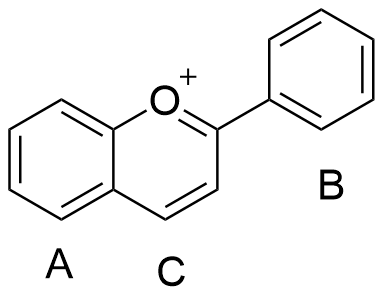Anthocyanins Analysis Service
Anthocyanins are a class of natural pigments widely found in plants, belonging to the flavonoids. Their basic structure includes a phenyl ring (A ring) and a six-membered oxygen-containing ring (C ring), connected by a bridge (B ring). Depending on the substituents on the B ring, anthocyanins can be categorized into different types: pelargonidin, cyanidin, peonidin, delphinidin, petunidin, and malvidin. These compounds are primarily found in petals, fruits, leaves, and stems, providing vibrant colors such as red, purple, blue, and black. In addition to their role in pigmentation, anthocyanins have various biological functions: (1) Antioxidant effect: They scavenge free radicals, reduce oxidative stress, and protect cells from damage. (2) Anti-inflammatory effect: They alleviate inflammation by inhibiting related enzymes and signaling pathways. (3) Anti-cancer effect: They inhibit cancer cell proliferation and metastasis and induce apoptosis through multiple mechanisms. (4) Cardiovascular protection: They improve vascular function, lower blood pressure, and prevent cardiovascular diseases. (5) Anti-diabetic effect: They help regulate blood sugar levels and increase insulin sensitivity, aiding in diabetes prevention and management.

MtoZ Biolabs offers comprehensive, customized services, including structural identification, quantitative analysis, and metabolomic analysis of anthocyanins and their metabolites, catering to the diverse needs of researchers, product developers, and industry professionals.
Services at MtoZ Biolabs
Anthocyanins Analysis Techniques
We utilize various analytical methods, including liquid chromatography-mass spectrometry (LC-MS), to separate and detect anthocyanins. LC-MS is a widely used technique, capable of identifying anthocyanins based on their mass-to-charge ratio and fragmentation patterns.
Analysis Workflow

Service Advantages
1. High Sensitivity and Specificity: Using advanced mass spectrometry, we can accurately detect and quantify anthocyanins and their metabolites, even at very low concentrations, ensuring reliable data.
2. Comprehensive Metabolic Profiling: We can detect individual anthocyanins and analyze their various metabolites, providing a thorough metabolic profile to help researchers understand anthocyanin metabolism and function.
3. High-throughput Analysis: Capable of analyzing numerous samples simultaneously, enhancing experimental efficiency and suitable for large-scale metabolomic studies.
4. Customized Services: We provide personalized analysis plans based on specific research needs, including sample preparation, data acquisition, processing, and interpretation, ensuring the achievement of clients' research objectives.
5. Data Reliability and Reproducibility: Through stringent quality control and standardized procedures, we ensure data accuracy and reproducibility, providing a solid foundation for scientific research.
6. Multidimensional Data Interpretation: Using various data analysis methods and bioinformatics tools, we can interpret data from multiple perspectives, helping researchers uncover potential biological significance and mechanisms.
7. Wide Application Fields: Anthocyanins metabolomic analysis has significant applications in food science, plant research, medical health, and other fields, supporting multidisciplinary research needs.
Applications
1. Plant Resource Quality Assessment
Anthocyanins, key secondary metabolites in plants, are influenced by species, environment, and growth stage. Measuring their levels evaluates plant quality and guides sustainable use.
2. Physiological Function Research
With antioxidant, anti-inflammatory, and anticancer properties, anthocyanins' levels in samples reveal their health benefits, supporting drug, food, and cosmetic development.
3. Product Quality Control
Anthocyanin stability is crucial for product quality and efficacy. Monitoring their levels ensures safety and protects consumer interests.
Sample Submission Requirements

How to order?







